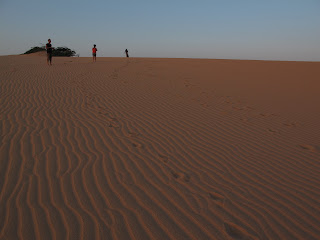La Guajira peninsula is Colombia's outback- untamed, sparsley populated, extremly remote and dry as dry can be. The peninsula juts out to form the northern most point of the South American continent; Punta Gallina (Chicken Point) is every bit as wind blown and rugged as you would expect the edge of a continent to be...and somewhat more windblown and rugged than I imagined the Caribbean coastline coud be.
Apparently people have been trying to tame this wild outpost for years- English pirates, Spanish conquistadors and later the Colombian authorities. The Wayyu indians have resisted such attempts for centuries and even today the region has a lawless feeling that comes from being simply too far from the centers of power for anyone to care what happens.
From Riohacha to Cabo de la Vela (the easiest part of the pensinsula to get to) it is around 3.5 hours of bumping along dusty red roads. Crammed into the back of a pickup truck wth us were 10 other adults, two children and a baby. We piled out in Cabo and quickly found a beachfront hut where we rented a couple of hammocks and settled in to the comatose pace of La Guijira.
With about 1500 inhabitants, Cabo is one of the bigger towns on the pensinsula, but still relies on generators for electricty and has to bring in all its fresh water. Being closer to Venezuela than any Colombian city of reasonable size, beer is mostly the Venezuelan Polar brand and contraband gasoline from across the border powers the generators and fishing boats.
We arranged transport up to Punta Gallina- half an hour or so by car to Puerto Bolivar and a two and half hour boat ride up to the northern tip of La Guajira. A few scattered familes live in almost complete isolation up here. The land is dry and barren, the sea wild and dangerous. It's hard to imagine a more unforgiving place to live.
On our second day we drove out to the massive sand dunes that rise steeply from the Caribbean, with spectacular views of the coastline and setting sun. The car overheated on the way and to make sure we arrived in time for sunset our driver bounced crazily along the sandy track as we bounced around like sacks of potatoes in the open top tray.
We arrived just in time to race up the steep slopes of the dunes and watch the sun dipping below the horizon.
Stunning.











.jpg)


.jpg)
.jpg)
.jpg)
.jpg)
.jpg)
.jpg)
.jpg)
.jpg)
.jpg)